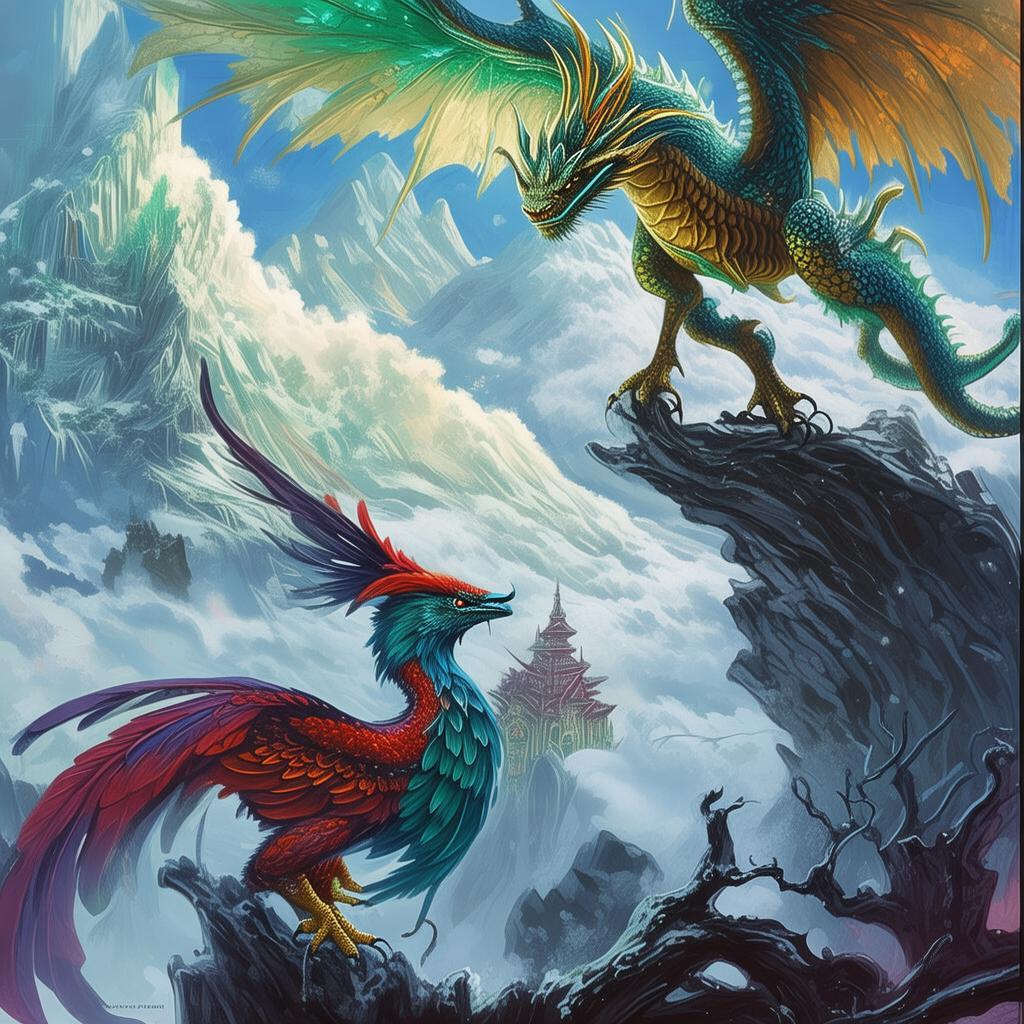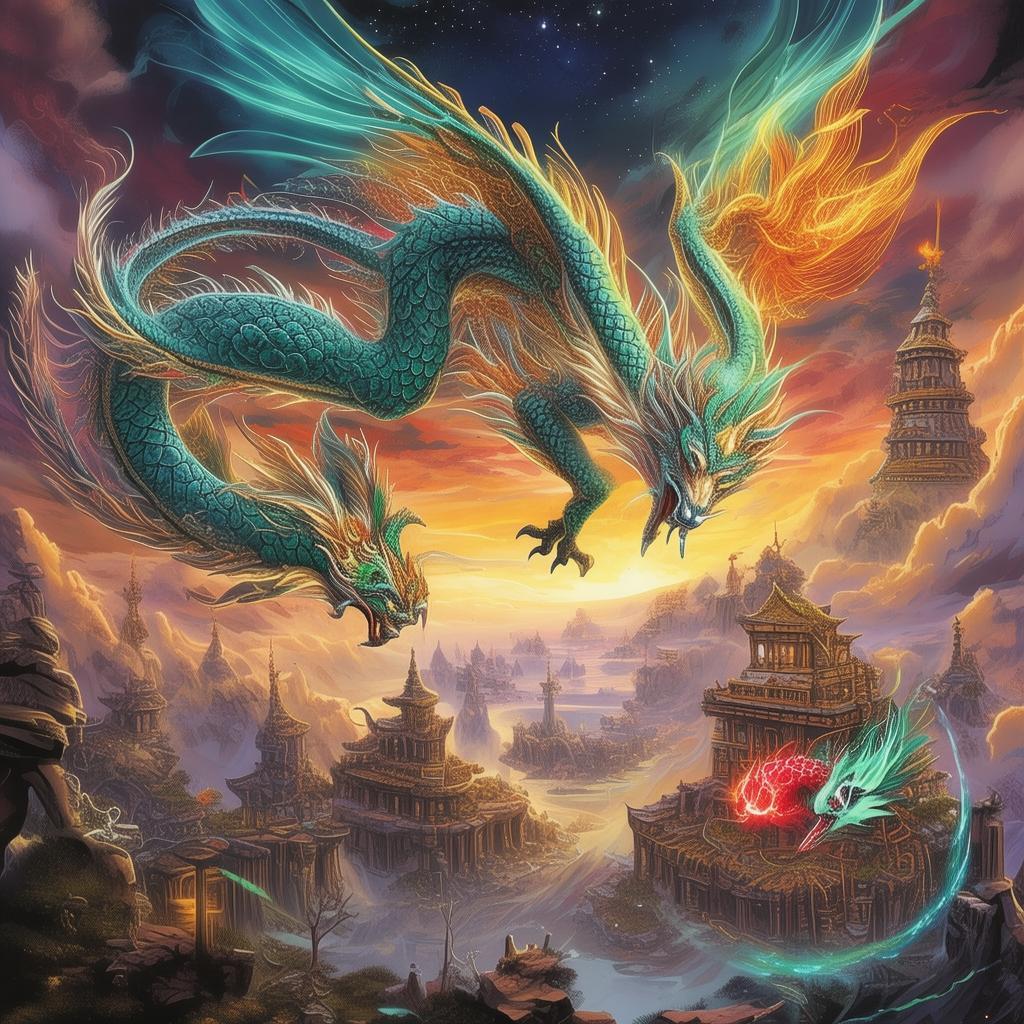Emerald Dragon's Lament: A Harmony of Elements Unraveled
In the heart of the ancient land of China, where the mountains and seas were whispered of in hushed tones, there lived a young composer named Ling. His talent was not in the strings or the woodwinds, but in the harmonious blending of the elements themselves. He believed that music could bridge the gap between the mortal world and the divine, a notion that had been whispered in the songs of the sages and the chants of the ancient.
Ling's latest composition, "The Dragon's Flight," was to be a symphony of the elements, a piece that would capture the essence of the world's most powerful mythical creature—the Emerald Dragon. The dragon, a guardian of the natural world, was said to be the embodiment of the four elements: earth, water, fire, and air. It was a creature of both terror and awe, its scales shimmering with the colors of the rainbow.
As Ling worked on his composition, he felt a strange connection to the dragon, as if the music itself was calling out to the mythical beast. The more he played, the more he felt the dragon's presence, and the music began to take on a life of its own. It was as if the elements themselves were responding to his melodies, their energies weaving through the air, the strings, and the very essence of his being.
One evening, as the sun dipped below the horizon, casting a golden glow over the land, a figure appeared at the edge of Ling's studio. It was an old man, his hair as white as the snow-capped peaks, his eyes twinkling with ancient wisdom. He introduced himself as Master Hua, a keeper of the Mountain and Sea Classic, the ancient text that held the secrets of the mythical creatures and the elements.
"Your music," Master Hua began, "is not just a composition; it is a call to the dragon. The Emerald Dragon has felt your song and has answered. But it is not a harmonious response. The dragon is in pain, and the balance of the elements is unraveling."
Ling was taken aback. "How can this be? My music is meant to bring harmony."
"The elements," Master Hua explained, "are not just a part of your composition; they are a part of the world. Your music has touched the dragon, but it has also awakened the discord within it. The dragon's flight is not one of joy but of struggle."
As the days passed, the connection between Ling's music and the Emerald Dragon grew stronger. The dragon's pain was a reflection of the world's imbalance, and the music was a mirror to that discord. The earth trembled, the waters roiled, and the air grew heavy with the weight of the dragon's suffering.
Ling realized that he was not just a composer; he was a key player in a much larger game. The world needed his music, not just to bring harmony to the dragon, but to restore the balance of the elements. He needed to understand the true nature of the dragon's flight and the underlying cause of its pain.
Master Hua guided him through the ancient texts, teaching him about the sacred mountains and the hidden valleys where the elements were strongest. They journeyed through the land, seeking the source of the dragon's suffering, their path marked by the signs of elemental turmoil.
As they reached the peak of a sacred mountain, they found a hidden cave where the dragon lay, its scales dull and its eyes hollow. The dragon's voice was a low, mournful wail, a sound that resonated with the very essence of the elements.
Ling played his composition, and the dragon's eyes flickered open. The music reached into the dragon's heart, and for a moment, it seemed that the discord would be soothed. But then, a new note was introduced—a dissonant sound that caused the dragon to flinch.
"This," Master Hua said, "is the root of the problem. The harmony you seek is not just a matter of music; it is a matter of balance. The dissonant note represents the imbalance in the world, the chaos that threatens to consume us all."
Ling understood. The composition was not just a piece of music; it was a map to the heart of the world's discord. He needed to find the source of the dissonance and correct it. And so, with Master Hua by his side, he set out on a quest to restore the balance of the elements.
Their journey took them through the deepest valleys and the highest peaks, where they encountered the spirits of the elements, each one a guardian of the natural world. They faced trials and tribulations, their resolve tested at every turn. But through it all, Ling's music remained a beacon of hope, a reminder of the power of harmony.

Finally, they reached a hidden grove where the four elements were strongest. Here, they found the source of the dissonance—a powerful force that had been disrupting the balance of the world. With the help of the spirits of the elements, Ling and Master Hua confronted the force, and through a combination of music and ancient wisdom, they were able to neutralize it.
The world responded with a collective sigh of relief. The earth stopped trembling, the waters calmed, and the air cleared. The Emerald Dragon's scales began to shimmer once more, and its eyes regained their luster. The dragon's flight was no longer a struggle, but a dance of joy, a celebration of the restored balance.
Ling's composition had done more than just bring harmony to the dragon; it had restored the balance of the entire world. The music had become a force for good, a testament to the power of harmony and the interconnectedness of all things.
As the world returned to its natural order, Ling and Master Hua returned to their respective paths. Ling's music continued to inspire, and the Mountain and Sea Classic was once again a guide for those who sought to understand the mysteries of the world. And the Emerald Dragon, now at peace, soared through the skies, a guardian of the elements, a symbol of the harmony that Ling had brought to the world.
In the end, Ling realized that his music was not just a composition; it was a story, a tale of the interconnectedness of all life and the power of harmony to overcome discord. The Dragon's Flight was not just a piece of music; it was a journey, a journey that had changed the world forever.
✨ Original Statement ✨
All articles published on this website (including but not limited to text, images, videos, and other content) are original or authorized for reposting and are protected by relevant laws. Without the explicit written permission of this website, no individual or organization may copy, modify, repost, or use the content for commercial purposes.
If you need to quote or cooperate, please contact this site for authorization. We reserve the right to pursue legal responsibility for any unauthorized use.
Hereby declared.









